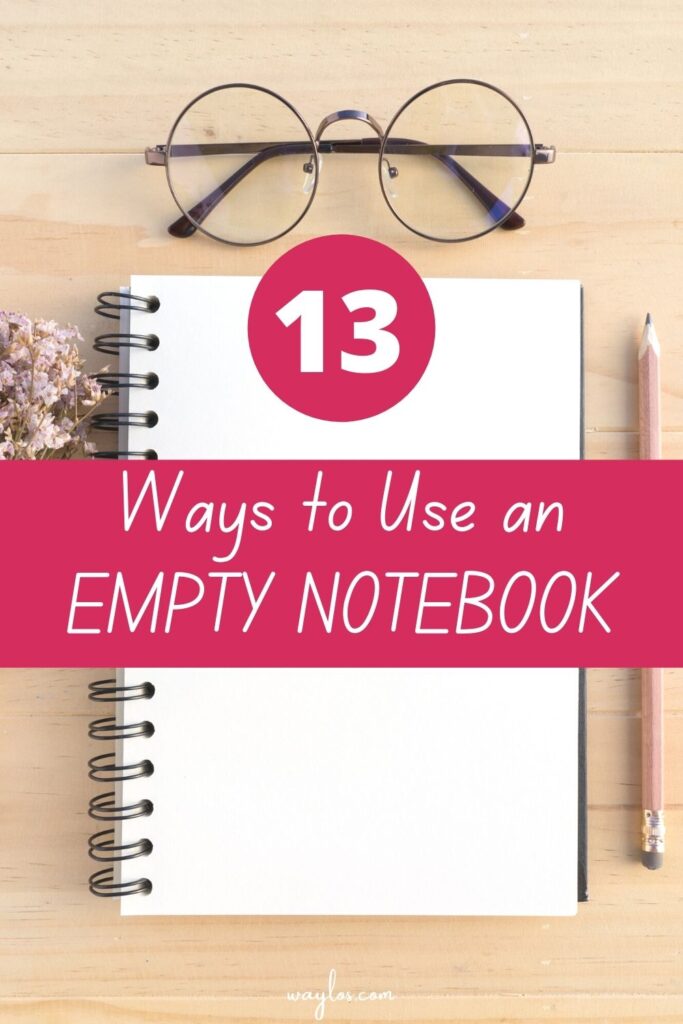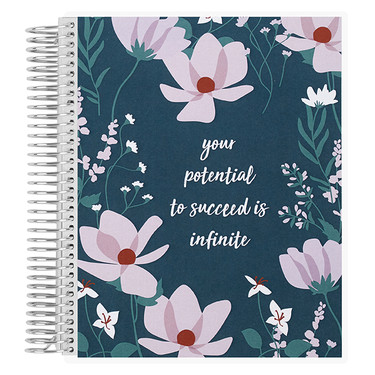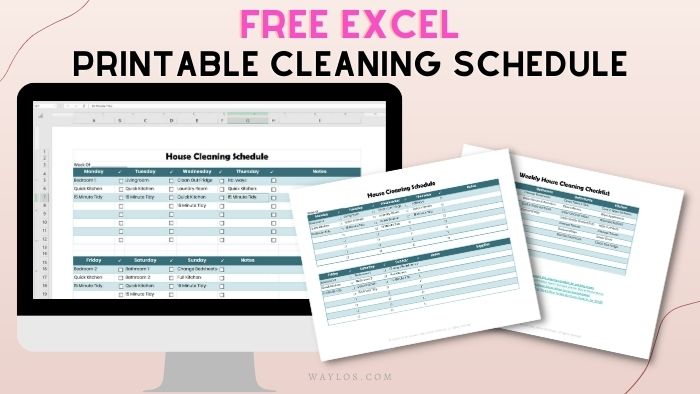Here’s How to Use Notebooks to REALLY Uplevel Your Life
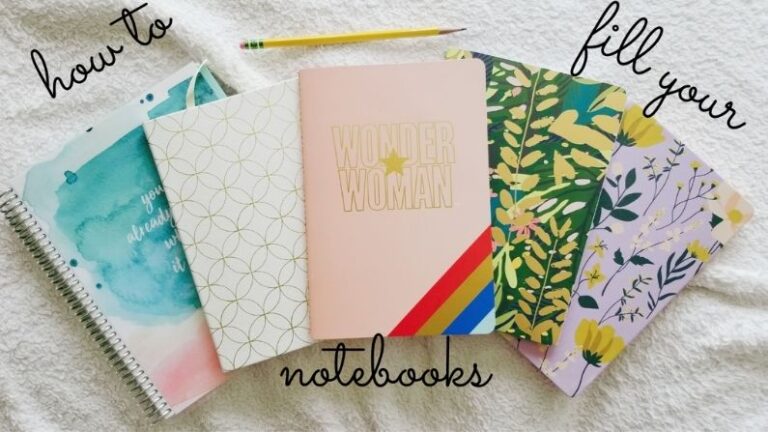
I’m sharing with you a bunch of functional, useful ways to use notebooks, either using up some notebooks you have lying around, or picking up some pretty notebooks at a great price.
If you want to start putting your notebooks to good use, or start incorporating notebooks into your organization and life management in a really helpful way, then keep reading!
Before we start, if you like videos better, here is my YouTube video all about how to use notebooks in your day-to-day life:
There are a LOT of fabulous uses for your notebooks in this video, so if you want to skip around to the different notebooks, the timeline is in the description.
How to Fill a Notebook
I have been trying to organize my office space and pulling things out, and I realized I have like ten notebooks!
I love to use notebooks, especially because every time you turn the page, you get a totally clean slate!
Notebooks can be functional, they can be therapeutic, they can keep schedules, keep memories, keep secrets…..and lots of them are too pretty to pass up!
This post tells you exactly how to fill a notebook with useful and helpful prompts, that will help you TODAY to organize all the pieces of your life.
How to Use Notebooks to Organize Your Life
I’m showing you exactly how to use notebooks to UPLEVEL your everyday life.
Whether they are half-used notebooks or totally blank notebooks, you will find something awesome to do with your notebooks from this list:
1. Running To-Do List Keeper
A running To-Do List Notebook is a place you can write in when a task pops into your head, instead of grabbing the nearest back of a piece of paper that gets thrown out by somebody else, or using a random stickie note that ends up getting lost.
Each time you have something to do that you can’t do right then and there, write it in your Running To-Do List Notebook. Now you have a running list of tasks to choose from when you are planning out each day or week.
Your Running To-Do List in your notebook is something you can look at each morning, or each evening the night before, to pick two or three important tasks that you can do on that day.
Or, you can group a few “like” tasks together to do on a specific day….maybe they’re in the same room, or you want to bake more than one thing while the oven will be on, things like that.

Here’s a BIG TIP for your to-do list notebook: keep this notebook small, so you can either bring it with you or keep it close to you, without it being a hassle to go looking for it.
Because if you don’t have it near you, you’ll be more likely to write the thing on something else instead, and that’s how things get lost in the shuffle.
If you want to learn more about using a running to-do list to organize your tasks and get them on your planner, read my post here.
2. DONE List Notebook
If you keep separate planners for work, life, side hustle, etc. like me, the day can turn into a swirling tornado of tasks, and by the end of it you don’t even remember what you got to.
It can feel like you didn’t get anything done, when you actually got a LOT done.
A DONE List notebook is where you make a list of the things you DID on that day. It’s’ a great place to be able to look back on your day, or week, and really feel it…..yes I DID accomplish it, yes I did do that thing that was bugging me for the past two weeks.
Plus, you’ll be able to tell a lot better what your line items for the next day should be, when you know right away what you did the day before.

This is my second favorite notebook. Your DONE List can even live on the back of your running to-do list notebook if you don’t want a completely separate notebook.
3. Schedule Keeper/Bullet Journal.
Besides the fact that in a bullet journal everything is exactly where you want it to be & you aren’t confined to certain color schemes like store bought planners can be sometimes, a schedule keeper (or bullet journal) is so therapeutic to:
- write out each month and each day,
- try new styles when you get bored of some weeks,
- try out using a whole page for a day, then try a whole week in a page, etc.
It can literally be whatever you want it to be. It’s so fluid and can be as simple or as elaborate as you can dream up.
Instagram and Pinterest are great places for inspiration if you want to just use a plain notebook to keep your schedule instead of investing in a planner, which can definitely be pricey sometimes.
4. Brain dump Notebook
Essential. The Brain Dump notebook is one of the most important notebooks in my arsenal.
Your brain does NOT double as a filing cabinet. It pulls random memories based on whatever you are looking at in the present moment. That’s why something random will trigger you to go, “OH I forgot to go to the bank, change the lightbulb, etc.”
Expecting your brain to organize your to-dos is a recipe for disaster, and many forgotten tasks. Enter the Brain Dump Notebook!
This notebook can be as messy or as structured as you want. My brain dump notebook is more structured, so instead of just free-writing, I give each page three columns:
- Home,
- Work, and
- Business
I free-write into each section, so when I go back to it I’m not reading through the whole page searching for that etsy printable idea that I jotted down in between “I hate dishes” and “I gotta follow up on those accounts receivable blah blah blah.”
I have a blog post all about how to use brain dumping in a controlled way, to convert your random, jumbled thoughts into the “taken care of” box.
If you are someone who holds a lot of information in your head and ends up forgetting things, you should definitely check out that post, and grab one of your unused notebooks.
5. Brainstorming Notebook
Very, very different from brain dumping. This is a space where if you have a side business or you work in a creative field, or even if you are thinking up a dream vacation or birthday celebration, it’s where you can keep your creative ideas.
For example, I have an etsy printables shop. When I have an idea for a printable, I take half a page from my brainstorming notebook to sketch out a mini version, write out my keyword research, and see if my idea is something people are looking for or need help with.
And, when I make that product and it’s listed in my shop, I put a big check next to the notes in my notebook. Same for my blog post ideas and my youtube ideas.
I suggest a more regular-sized 8.5in x 11in notebook, so you have more space to doodle, sketch & jot.
6. Budget Notebook/Financial Goals Tracker
Another way to fill an empty notebook is with your Budget and Financial Goals tracker.
Budget…..we all have to do it, there’s no running away from it. But we CAN make it look good!
Budget notebooks can keep:
- spending trackers,
- savings goals,
- sinking funds trackers,
- a vision page for your five-year plan or ten-year plan, and more.
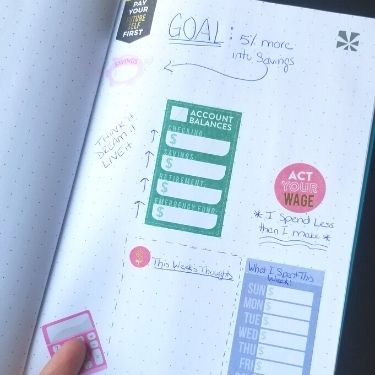
If you need help setting financial goals I have a very thorough guide, and it has a TON of examples if you’re stuck on what you want your financial life to look like in the next year, five years or ten years.
A Budget notebook is a great example of how to use a notebook effectively.
7. Social Media Tracker
When you’re a blogger or influencer, sometimes you have to keep track of what social media posts got posted and when, especially when you are working with a brand.
I use a notebook to track when I’ve pinned images to Pinterest. I’ve found that it’s much easier to keep track when I can just skim the last page or two of my notebook, to see what pieces of content can use a new pin.
8. Reading Log
A Reading Log notebook is the perfect place to keep special quotes or ideas from books you’ve read, instead of highlighting your book and then forgetting which page it’s on. Or even worse, what book it was in (I’ve done this so many times).

This is especially helpful when you are reading nonfiction, motivational and self-help books. These types of books have action steps or examples that you want to remember or think back on, or even use as a prompt for notebook number 9, which is…..
9. Journal
This notebook can be an overall journal day to day, or journaling for a specific purpose. For example, I’m using journal prompts specifically surrounding money right now, to write out:
- my emotions surrounding money,
- my fears around spending and keeping money, and
- how I can work on a more positive relationship with money.
But, a journal can be for anything you want to examine more closely. Here are some more examples:
- Dream journal
- Symptoms log or food journal, if you are dealing with a chronic situation
- Doodle/sketches journal
- Gratitude journal
- Feelings journal
- Bible study journal
If you are wondering what to use a small notebook for, a journal would be perfect.
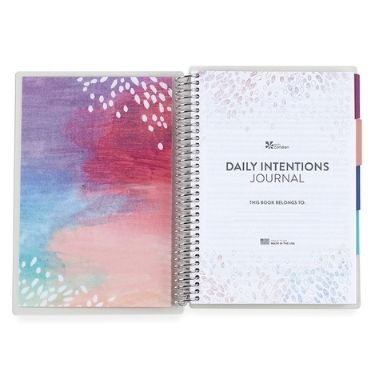
from Erin Condren
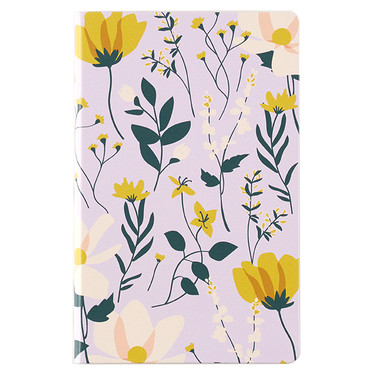
from Erin Condren
10. Goal Tracker/Habit Tracker
If you don’t know what to do with a blank notebook, Goal & Habit Trackers are a functional, useful addition to your notebook game.
A big plus is that these types of trackers are usually really pretty & nice to look at, both because they are graphs & charts that look contained & not chaotic (clean = happy lol), and they’re really easy to decorate in the corners with little stickers & things.
If you are going big with some year or quarter goals, I highly suggest a 3-subject or -4 subject notebook. This makes it very easy to break your year into quarters or thirds, or you can break up the notebook by goal or by habit, and use the pages for journaling, inspirational quotes, and tracking your progress.
11. Vision Board
My vision board was actually done on my COMPUTER in January this year. I made it my wallpaper, and guess what? I NEVER see it, because I have so many tabs open all the time!
So, I decided to move my vision board to a notebook, where I can see it whenever I need a little boost of motivation.
Keeping your vision board in a notebook is great for when you want to USE a vision board, but you don’t want it on your wall. Maybe you just want YOU to see it, not the whole house.
12. Routines Notebook
This notebook can keep lists of any tasks you do (or want to do) on repeat, like:
- Morning Routine;
- Self-Care Routine;
- Evening Routine;
- Home Maintenance Routines: Weekly, Monthly, Seasonally & Yearly;
- Cleaning Routine; etc.
Having a notebook that houses these routines can be very precious and necessary to us when the outside world is NOT AT ALL structured. It’s nice to have a “home base” that keeps the needs & wants of the house and family, to help structure our time throughout the day.
If you have a small notebook that you don’t know what to do with, a Routines Notebook is a great fit.

13. Handwriting Practice Notebook
I saved my most favorite notebook for last. I don’t know about you, but my handwriting is so bad!
Like, embarrassingly bad.
I’ve been using a notebook to practice my handwriting. It slows me down and helps with my muscle memory to make neat letters. All day long I’m going super-fast and anything I write is all scribble-scribble-scribble, and when I want to write a nice “thank you” note….it looks like crap!
So, my new favorite thing to do is scroll through Etsy and find practice sheets for $1-$2. There are so many nice ones to practice print, script or that gorgeous bullet-journal-esque hand lettering.

A handwriting practice notebook is a nice, calming addition to your evening routine, to come down from the fast pace of the day, and slow yourself down.
That’s how to use notebooks to organize and uplevel your life!
Do you have any ideas or ways you use your notebooks? What do YOU fill notebooks with? Let me know in the comments below!
XO,
-Mina
PS: Here are some more posts you may find useful!
- How to Color-Code Your To-Do List
- 10 Small Habits to Boost Your Productivity Right Now!
- How to Simplify Life & Actually Stop Wasting Your Time
